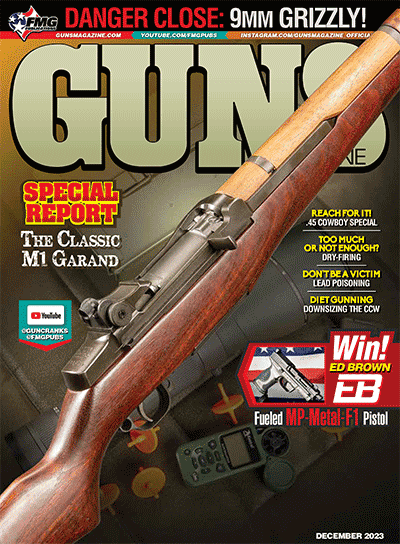Four Cleaning "Secrets"
Work Smarter, Not Harder!
Let’s face it: Gun cleaning can seem overwhelming to the newcomer. Poking my head into Brownells, there’s hundreds of different cleaners, degreasers, oils and devices — and just as many opinions among shooters about which ones to use and how often to use them. While I can’t say whether the newest fluids to hit the market outperform what I’ve been using for years, I can share four of my own “secret” tips that make a big difference when it comes to tackling a chore I’ve never particularly enjoyed.
1. Get the gunk out when everything’s dry
Many shooters’ first instinct is to hose a dirty gun down with some type of cleaning compound. However, the drawback to this method is that if you can eyeball visually distinctive bits of crud in the crevices of your gun, going gonzo with any kind of spray bottle or aerosol can is just going to turn dirt into mud. At that point, brushing will smear a mess around and increase cleaning time.
Instead, I offer this — if a gun is particularly gross, start first by using a dry nylon brush and let any goobers drop free onto the ground, cleaning towel or shop mat. For really caked-on gunk in the deep crevices of slide channels, locking lugs or whatever else, I like to use a set of brass or nylon picks. With just light hand pressure, you’ll be able to break a lot of detritus free.
2. Use a “lead-away” cloth on stainless guns
A number of manufacturers including Hoppe’s, Birchwood Casey and Kleanbore offer a chemical-impregnated silicone cloth for quickly removing lead and powder fouling from any stainless surface. If you want to know what a lot of GUNS writers use to get good pictures of the stainless guns we shoot one helluva lot, here’s your answer.
It seems like hyperbole to say this stuff works like magic but you’d be amazed how a gunky stainless steel gun can be restored to what appears factory-new by 20 seconds of half-assed wiping. It’s amazing, for example, at removing powder residue around muzzles and on the faces of revolver cylinders.
This being said — do not use these products on blued steel finishes and consult the manufacturer before you use it on anything that isn’t stainless.
3. Wheelgunners: Get a Hoppe’s “Tornado” brush
Perhaps no cleaning task is as daunting to revolver shooters as getting rid of the dreaded “cylinder rings” that build up just forward of the fired round in each chamber. Not only can they be a bear to remove but there’s a chance they can impede functioning. A thick ring of crud built up from a steady diet of shooting .38s through a .357 revolver can make chambering and extracting the longer magnum rounds extremely difficult.
Fortunately, Hoppe’s comes to the rescue with its spiral-wound, stainless steel “Tornado” brush. This pattern is very aggressive at removing those stupid rings. When I feel chambering or extraction getting a little sluggish on my wheelguns, about six back-and-forth strokes per cylinder handily removes the problem.
4. You don’t have to clean a gun after every range trip
There’s an interesting dichotomy I’ve found in the gun world: Consumers want the same battle-hardened, hellfire-tested, faultlessly reliable firearms used by soldiers and law enforcement. You know, the kind that can go thousands of rounds between failure? But once in their possession, those same shooters are afraid their guns will malfunction if they look at them wrong.
Let me say this first: Ignore this bullet point if you want to maximize reliability with a CCW gun or home defense firearm. If you’re counting on something to defend life and limb, you owe yourself to ensure it’s always in a condition of optimal functioning. Also ignore me if you’re shooting corrosive surplus primers.
But beyond this specific case? 99.9% of the time, a quality gun will run a little dirty. I’ve often told people most of my guns tell me when they need to be cleaned. If slides feel a little slow returning to battery, if extraction feels a little sticky or if small parts feel gritty moving past one another, you’re getting hints your firearm might need some attention.
Again, you’ll usually feel such issues well before they begin to hinder reliability. The corollary to this is if your “fun” guns aren’t giving you any indication they need to be cleaned, why add a new task to your to-do list? So go ahead and put the range toy back in the safe even if you put 50 or a hundred rounds down the pipe — it won’t tell anyone.





